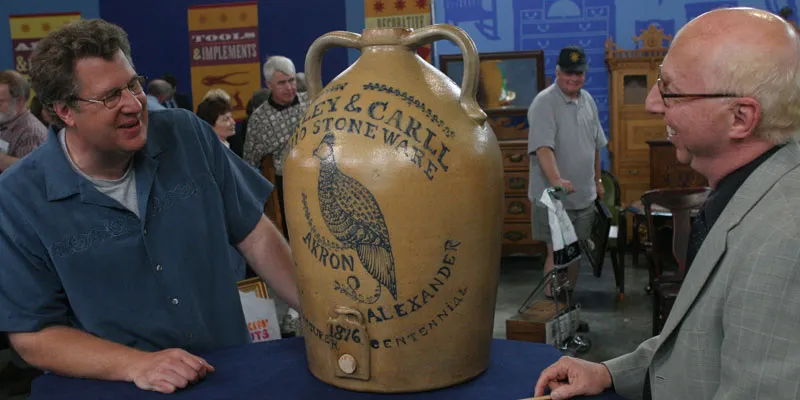What's the Value of Research?
Our experts may know their stuff, but sometimes it takes a long time to fully decipher the story of a piece that airs on the show.

Jun 17, 2019
Originally published on: Jan 10, 2005
Sometimes it takes ANTIQUES ROADSHOW appraisers a long time to fully decipher the story of a piece that airs on the show. That's been true for Allan Katz, a Woodbridge Connecticut dealer who specializes in American folk art. Ever since he first set eyes on a large stoneware jug at the St. Paul ANTIQUES ROADSHOW in summer 2004 — his first time at the ROADSHOW — he has been trying to figure out the piece's origins and history.
At the event, he had only about 15 minutes to do his first round of research. That's how much time the show's producers could give him before they videotaped his appraisal as part of the St. Paul show. Allan hurriedly tried to make his investigations.
He asked the Keno brothers about the piece, knowing that they collected stoneware. But their expertise resided in New York State stoneware, and this water cooler was clearly made in Ohio — the words "Ohio Stoneware" were drizzled in cobalt on its side. The appraiser then did an online search on the computer that is available to all appraisers at each show, typing in the phrase "Harley & Carll," which he had found written on the side of the jug. But that search turned up nothing.
Time was up. "I let the piece do the talking," Allan said. When the cameras rolled, he told the owner that the piece's size — it's over two feet tall and weighs 80 pounds — indicated it was not a practical everyday jug, but a presentation piece meant for show. "Let's just say it wasn't used by the boys at the shop to take a drink of water from," he said. Allan also noted that the piece was decorated from top to bottom: as well as words, there was a date and a magnificent peacock drawn with a cobalt slip. Stoneware that has such all-over decoration is known in the business as having a "full palette."
"That's what we in American folk art are looking for in a great piece of American stoneware," Allan told the jug's owner.
A stoneware expert goes to extra lengths in an effort to learn the origins of a newly discovered jug
He also told the owner that the words "Akron" and "Alexander," which are also inscribed on the jug, might refer to where the jug was made in Ohio. And he said that the phrase "Harley & Carll," written above the peacock, was probably the name of the maker. The last clue was the year "1876" and the word written next to it — "Centennial."
"This makes me speculate that it might have been used in the centennial celebration in Philadelphia in 1876," Allan told the owner on camera, referring to the nation's 100th anniversary celebration. "The various states had exhibits and this might have been an example of an Ohio stoneware maker put in the exhibit there." Allan made it clear, though, that he was doing guesswork based on the limited facts at hand. "This is a piece we still need to do some research on," he said.
The first thing he did upon returning to his office was to check his extensive library on stoneware, but his books offered no new information. He also called the Ohio Historical Society, and they told him that "Alexander" was not the name of a small town in Ohio, but the name of a well-regarded Ohio stoneware manufacturer of the day. That was useful information, but it threw into doubt who "Harley & Carll" were — something the historical society wasn't able to pin down. Allan has hired a researcher to investigate whether Harley and Carll were the company who sponsored the making of the jug, similar to the way a Budweiser might sponsor a product or exhibit booth today.
The researcher is also trying to track down photographs or drawings from the 1876 Centennial in the hopes of finding one that shows the jug in the Ohio exhibit. Such background information — especially an image from the Philadelphia Centennial in 1876 — could add significant value to the jug. He estimated its worth at between $65,000 and $85,000 on-air, which he now feels is conservative. Still, Allan says profit is not the primary reason he's making the effort.
"This jug is a new discovery," he explains. "The world didn't know it existed before this man brought it to the ROADSHOW. Now that we know it exists, it's my obligation to document what the piece is about. It's our responsibility to close all these loops so that future generations can view it in its correct context."
See the 1876 John Alexander Stoneware Jug below!




